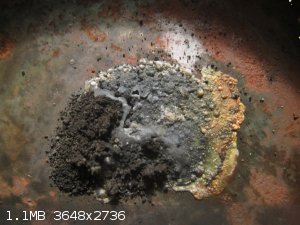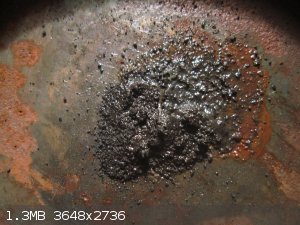12thealchemist
Hazard to Others
  
Posts: 181
Registered: 1-1-2014
Location: The Isle of Albion
Member Is Offline
Mood: Rare and Earthy
|
|
Making potassium cuprate(III)
A glass jar with a previously-burned steel lid was filled with oxygen and inverted. A small piece of potassium metal was placed in the centre of the
lid and covered with copper(II) oxide. The lid was fitted to the jar, and the potassium heated strongly to ignite it. When the flames had died down,
it was found that a blue-grey solid had formed on the inside of the lid, surrounded by a yellow-orange crust and unreacted copper oxide.
It was concluded that the blue-grey material was potassium cuprate(III), and the yellow material was a mixture of various potassium oxides. This was
on the basis of colour, and the reside after exposure to air for a couple of days.
Potassium cuprate(III)

A couple of days later after being exposed to the air

[Edited on 24-11-2018 by 12thealchemist]
|
|
|
Σldritch
Hazard to Others
  
Posts: 309
Registered: 22-3-2016
Member Is Offline
Mood: No Mood
|
|
I think you reached your conclusion a little bit too fast.
1. Cuprites are blue; it looks more like Potassium Oxide with some Potassium Cuprite dissolved.
2. I do not think you heated it long enough to oxidize both the copper and potassium, especially since you seem to have formed a protective Potassium
Oxide layer. And even if you heated longer i would expect it to be reduced by the iron surface below.
3. I know Copper (III) Oxide is red, while im not sure if that is the case for cuprates too it would make since judging by cuprites behavior. And even
if you saw any red it might as well be iron, anyway.
Maybe heat it longer on a less reactive surface or prepare the Potassium Peroxide first, not in situ. Im glad to see others interested in the higher
oxidation states of copper too, best of luck.
|
|
|
12thealchemist
Hazard to Others
  
Posts: 181
Registered: 1-1-2014
Location: The Isle of Albion
Member Is Offline
Mood: Rare and Earthy
|
|
Brauer's Preparative Inorganic Chemistry prepares potassium cuprate(III) by heating potassium oxide and cupric oxide to 300-400°C in an atmosphere of
oxygen. I assumed that the ignition of the potassium in a large excess of oxygen would achieve this, at least to some degree. I was never aiming for
purity.
The product is described as a "steel blue to deep blue" which is similar to what I prepared.
Could you expand on what you mean by potassium cuprite? Are you referring a cuprate(II) ion?
Also, I wasn't aware that copper(III) oxide had been isolated, and even then I thought it was copper(I) oxide that was red.
|
|
|
Σldritch
Hazard to Others
  
Posts: 309
Registered: 22-3-2016
Member Is Offline
Mood: No Mood
|
|
I thought you were going for the cuprate synthesis mentioned on wikipedia:
"One of the simplest oxide-based cuprates is the copper(III) oxide KCuO2. This species can be viewed as the K+ salt of the polyanion [CuO−2]n.
As such the material is classified as a cuprate. This dark blue diamagnetic solid is produced by heating potassium peroxide and copper(II) oxide in an
atmosphere of oxygen:[2]K2O2 + 2 CuO → 2 KCuO2 "
I guess that answers if it is blue or red, too. It is basicly the same synthesis since heating Potassium Oxide in oxygen should yield Potassium
Peroxide but again the iron will probably interfere before much happens in your case.
Copper (II) oxide dissolves in strong base such as Sodium or Potassium Hydroxide to make a blue solution, fusing Copper (II) Oxide and an alkali oxide
should have a similar effect. But it is copper (II) not (III), it gets confusing quickly with all the different oxidation states.
As for copper (III) Oxide i have only made it very impure a long time ago but here is some info on it:
"This copper peroxide, Cu2O3, is stated to be formed as an orange-yellow substance by electrolytic oxidation with a high current-density at a
copper anode immersed in concentrated caustic alkali, and also by the action of alkaline hypochlorite and hypobromite on cupric hydroxide and copper.
Various investigators have described a compound with the same formula. An example is the interaction of potassium persulphate with a mixture of cupric
hydroxide and barium hydroxide cooled with ice and salt, colour changes taking place in the solution, and a tenuous, amaranth-red precipitate being
deposited. The substance formed yields oxygen with sulphuric acid, liberates chlorine from hydrochloric acid, oxidizes ammonia in the cold to nitrogen
and nitrous acid and traces of nitric acid, decolorizes permanganate, and liberates iodine from potassium iodide. It is not a peroxide, since with
dilute acids it does not yield hydrogen peroxide, and therefore differs from the orange-yellow peroxide obtained by means of hydrogen peroxide. The
ratio between the percentages of copper and active oxygen present corresponds with the formula Cu2O3." (From atomistry)
This thread might interest you too: http://www.sciencemadness.org/talk/viewthread.php?tid=72833
|
|
|
12thealchemist
Hazard to Others
  
Posts: 181
Registered: 1-1-2014
Location: The Isle of Albion
Member Is Offline
Mood: Rare and Earthy
|
|
Yes, that is precisely what I was after, and purely how I planned the synthesis. I have since tracked down the reference, which is Brauer. I may try
again some time; but with a slightly more complicated set up - burning the potassium in copper oxide under a stream of oxygen in a porcelain crucible.
However, since I don't have such a crucible, it may be a while before I attempt this again.
It is indeed possible that I formed the potassium cuprite(II), by fusion of the two oxides. I was hoping that the excess oxygen in the set up would
help avoid this, though.
That information about copper(III) oxide is very interesting! And atomistry.com too! It's a remarkable website. I may try making copper(III)
sesquioxide and/or copper(II) peroxide at some point too.
Referring to your comment about others being interested in high-valence copper, unusual oxidation states of the elements is something that interests
me generally. A compound I would love to see synthesised a Zn(III) complex, which should have a d-d transition. However, Zn(III) is not known.
[Edited on 24-11-2018 by 12thealchemist]
|
|
|
Metacelsus
International Hazard
    
Posts: 2531
Registered: 26-12-2012
Location: Boston, MA
Member Is Offline
Mood: Double, double, toil and trouble
|
|
I would be concerned about the potassium metal reducing the copper (II) oxide to metallic copper. It would probably be better to burn the potassium
first, and then heat the product with copper (II) oxide.
|
|
|
|